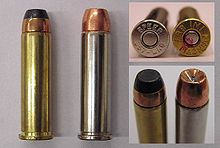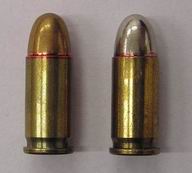Rim (firearms)
A rim is an external flange that is machined, cast, molded, stamped, or pressed around the bottom of a firearms cartridge. Thus, rimmed cartridges are sometimes called "flanged" cartridges. Almost all cartridges feature an extractor or headspacing rim, in spite of the fact that some cartridges are known as "rimless cartridges". The rim may serve a number of purposes, including providing a lip for the extractor to engage, and sometimes serving to headspace the cartridge.
Types
There are various types of firearms rims in use in modern ammunition. The main types are categorized as rimmed, rimless, semi-rimmed, rebated, and belted. These describe the size of the rim in relation to the base of the case.

Rimmed
The rimmed cartridge, sometimes called flanged cartridge, is the oldest of the types and has a rim that is significantly larger in diameter than the base of the cartridge. Rimmed cartridges use the rim to hold the (usually straight sided) cartridge in the
This allows some firearms chambered for similar rimmed cartridges to safely chamber and fire shorter cartridges, such as using

Rimmed cartridges generally do not work quite as well in firearms that feed from a
is extremely popular in semi-automatics.Rimmed cartridges work with belt-fed machine guns that use a two stage Pull out – Push through feeding operation, notably the
Under the
Examples of rimmed handgun cartridges include the

Rimless
The rim on a "rimless" case is almost or exactly the same diameter as the base of the case. A recess formed between the rim and the body of the cartridge is known as an
Since a straight-walled rimless cartridge is designed to headspace off of the case mouth, this prevents the ammunition loader or manufacturer from using a heavy crimp, which is a ring pinched or "crimped" into the cartridge case, designed to lock the bullet securely in place until fired. Crimping affects the overall length of the cartridge, and thus cannot be used on cartridges which headspace on the case mouth. This can be a problem for magnum revolvers or rifles which simultaneously chamber more than one round of ammunition, as the recoil from the firing successive rounds can loosen the bullets in the remaining cartridges, and cause their bullet seating depth to change, which can have a serious effect on accuracy, or could, in the case of a revolver, cause a bullet to protrude sufficiently from the front of the cylinder to obstruct the revolving of the cylinder thus jamming the gun from firing additional rounds. This is not an issue for
Examples of rimless handgun cartridges include the
Semi-rimmed

On a semi-rimmed case the rim projects slightly beyond the base of the case, though not as much as a rimmed cartridge. The tiny rim provides minimal interference feeding from a
The .38 Super, a higher pressure loading of the old .38 ACP case, is notorious for being less accurate than rimless cases, and so most modern .38 Super handguns are chambered so that the cartridge headspaces off the case mouth, like a rimless case. If the chamber is cut shallow, so the case headspaces off the mouth, the rim is used for extraction only; a standard chamber will use the rim for both headspacing and extraction.[4]
Examples of semi-rimmed handgun cartridges are
Rebated
Rebated cartridges have a rim that is significantly smaller in diameter than the base of the cartridge case, serving only for extraction. Functionally the same as a rimless case, the rebated rim allows a gun to be easily converted to fire a larger-than-normal cartridge, as most of a firearm's loading and extraction mechanism does not need to be altered as long as the rim size is preserved.[3] Another advantage with rebated rim cartridges, mostly with straight-walled examples allow the usage of virtually any lengths of cartridge of the same caliber.
An example of a rebated rim cartridge is the
The
The recent (early 2000s)
The only known Shotgun shell using rebated rims is the 12 Gauge RAS12, specially made for the RAS-12 semi automatic shotgun.[8]
The
Other rebated rifle cartridges include the
Rebated cartridges are used for a different reason on
An unusual example of rebated rim autocannon rounds have been used in the T168 autocannon prototype, the 30x120mmRB T268 which was designed for reverse loading of the rounds into the chamber. A telescopic example existed, the 23×260mm round used in the Rikhter R-23 autocannon that operated in a similar way.
Belted

The original purpose of the "belt" on belted cases (often referred to as
Examples of belted handgun cartridges include the .40 BSA Auto Pistol and .40 G&A Magnum. Belted rifle / machine gun examples include the .224 Weatherby Magnum, .300 Winchester Magnum, .375 H&H Magnum, .450 Marlin, .458 Lott, 13×64mmB and .55 Boys.
In the United States, the belt became somewhat synonymous with "magnum" during the late 20th century. More recently, new "magnum" cartridges introduced in the United States have been rimless or used rebated rims based on the .404 Jeffery that fit the same .512" bolt face used for the belted cases.[10]
See also
References
- )
- ISBN 978-1-61608-222-2.
- ^ ISBN 978-1-4665-8881-3.
- ISBN 0-87349-281-1.
- ISBN 978-1-63450-966-4.
- ^ ISBN 978-1-4402-4642-5.
- ^ ISBN 978-1-4402-3998-4.
- ^ "Shotshell type ammunition usable in magazine-fed firearms, and methods of manufacturing such shotshell type ammunition".
- ISBN 978-1-4402-3848-2.
- ISBN 978-1-4402-4658-6.
- Ackley, P.O. (1927) [1962]. Handbook for Shooters & Reloaders. vol I (12th Printing ed.). Salt Lake City, Utah: Plaza Publishing. pp. 197–202. ISBN 978-99929-4-881-1.


